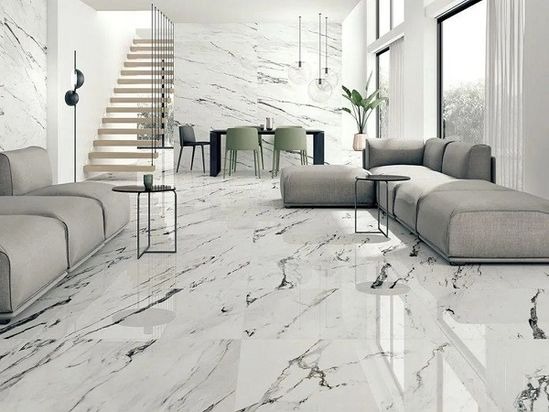Choosing the best flooring for each room depends on factors like durability, comfort, aesthetic, and maintenance. Here’s a breakdown of the best flooring options for different rooms in your home:
1. Living Room: Hardwood or Engineered Wood
- Why: The living room is often the centerpiece of your home, and hardwood or engineered wood flooring adds warmth and sophistication. It’s timeless and can complement any style, from traditional to modern.
- Pros: Durable, timeless, easy to clean, and can be refinished if needed.
- Considerations: Can be scratched by furniture or pets, but this can be minimized with area rugs.
2. Kitchen: Tile or Luxury Vinyl Plank (LVP)
- Why: Kitchens require a flooring material that can handle spills, moisture, and heavy foot traffic. Ceramic or porcelain tiles are a great choice, while LVP offers a waterproof, cost-effective alternative.
- Pros: Tiles are water-resistant, easy to clean, and come in a variety of designs. LVP mimics hardwood but offers more flexibility in wet environments.
- Considerations: Tiles can be cold underfoot, while LVP can sometimes look less natural than real wood.
3. Bathroom: Porcelain or Ceramic Tile
- Why: Bathrooms require flooring that can handle moisture, and porcelain or ceramic tile is a top choice due to its water resistance and durability.
- Pros: Water-resistant, easy to clean, and comes in various styles and colors. Tile is also non-porous, preventing mold and mildew growth.
- Considerations: Tile can be cold, so adding rugs or heated floors can enhance comfort.
4. Bedroom: Carpet or Hardwood
- Why: Bedrooms are all about comfort and relaxation, and carpet provides warmth and a soft feel underfoot. Alternatively, hardwood floors offer an elegant look and can pair well with area rugs for warmth.
- Pros: Carpet is soft, warm, and great for insulation, while hardwood provides a clean, stylish look that can suit any decor.
- Considerations: Carpet requires more maintenance (vacuuming and occasional deep cleaning), while hardwood may be too cold without the right rugs.
5. Dining Room: Hardwood, Engineered Wood, or Area Rugs
- Why: Dining rooms typically experience heavy foot traffic and the occasional spill, so you want a flooring material that’s both durable and easy to clean. Hardwood or engineered wood are great choices, as are tile options for a more contemporary look.
- Pros: Durable, easy to clean, and offers a classic look. Adding area rugs can help protect the floor and add warmth.
- Considerations: Be mindful of spills, especially on hardwood or engineered wood floors. Rugs can help, but they need to be cleaned regularly.
6. Hallways & Entryways: Tile, Hardwood, or Luxury Vinyl Plank
- Why: High-traffic areas like hallways and entryways need a flooring material that can withstand wear and tear, so tile, hardwood, or luxury vinyl plank work well here.
- Pros: All of these options are durable, easy to clean, and look great. LVP is a good budget-friendly option that also holds up well in these areas.
- Considerations: Consider slip resistance in entryways, especially if you live in an area with wet or snowy conditions.
7. Basement: Luxury Vinyl Plank or Carpet
- Why: Basements are prone to moisture, so it’s crucial to select flooring that’s moisture-resistant. LVP is an ideal choice, offering the look of hardwood with moisture protection. Alternatively, carpet can add warmth but should be avoided in areas prone to flooding.
- Pros: LVP is durable, water-resistant, and easy to maintain. Carpet provides warmth and comfort but requires proper moisture control.
- Considerations: If you choose carpet, make sure to install a moisture barrier to protect it from basement humidity.
8. Home Office: Hardwood, Laminate, or Carpet
- Why: For a home office, you want something that’s both comfortable and professional. Hardwood or laminate offers a clean, sophisticated look, while carpet provides warmth and sound absorption.
- Pros: Hardwood and laminate are easy to maintain and stylish, while carpet can reduce noise, making it ideal for a quiet workspace.
- Considerations: Laminate may show wear faster than hardwood, and carpet may require more upkeep.
9. Laundry Room: Tile or Luxury Vinyl
- Why: The laundry room is often exposed to moisture, so you’ll want something that can handle spills and humidity. Tile or luxury vinyl plank is durable, moisture-resistant, and easy to clean.
- Pros: Water-resistant, easy to clean, and resistant to stains.
- Considerations: Make sure to choose non-slip options, especially if the room gets wet often.
10. Staircase: Hardwood, Carpet, or Stair Treads
- Why: Stairs need durable, safe flooring. Hardwood adds elegance, while carpet provides comfort and reduces noise. For a mix of durability and safety, stair treads can be added to a hardwood staircase.
- Pros: Hardwood is durable and stylish, while carpet can offer a cushioned feel. Stair treads provide extra grip.
- Considerations: Carpet may show wear in high-traffic areas, while hardwood can be slippery unless tread mats are used.

